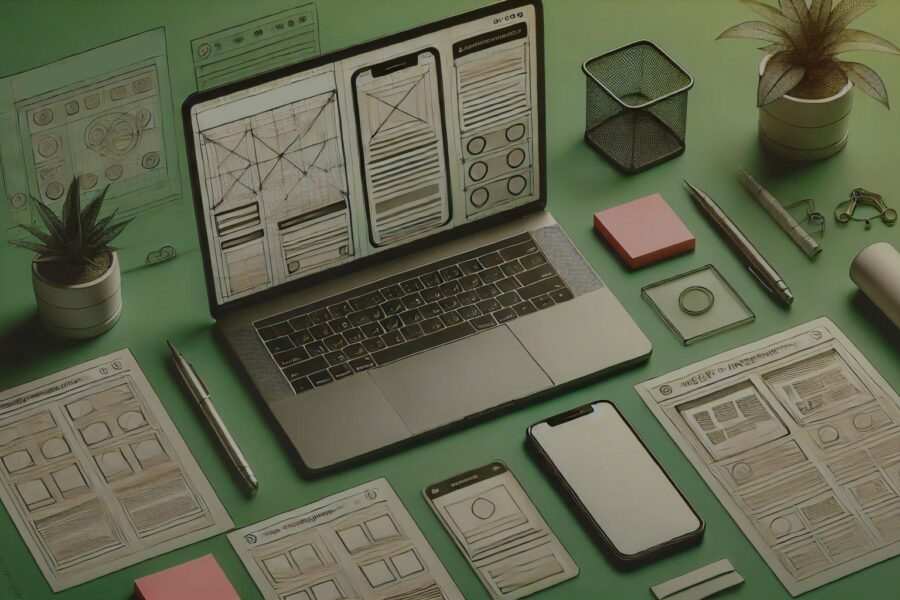Introduction:
In the fast-paced digital landscape, user experience (UX) design has emerged as a cornerstone for developing successful digital products. Whether you are building a mobile app or a website, a well-thought-out UX can significantly enhance user satisfaction and engagement, leading to better retention and customer loyalty. In this blog post, we will explore how UX design can elevate a product by creating intuitive, seamless experiences that cater to the user’s needs and expectations.
What is User Experience Design?
User Experience Design focuses on the interaction between users and products, services, or systems. Its primary goal is to ensure the product is easy to use, accessible, and engaging for users. UX design involves multiple aspects, including research, design, prototyping, testing, and refining the user journey to make it as smooth and enjoyable as possible. It combines elements of psychology, design, market research, and technology to craft experiences that meet user expectations.
Why is UX Design Essential in Today’s Market?
Today’s digital products are no longer competing on features alone. User experience is a critical differentiator that can make or break a product. If users find a product difficult to navigate, they’re more likely to abandon it, regardless of how innovative it may be. A positive UX fosters trust and loyalty, which translates to increased user retention and customer satisfaction.
Key reasons why UX design matters:
- Increased Engagement: Intuitive interfaces encourage users to interact with your product more frequently and for longer durations.
- Higher Conversions: Well-designed user flows, clear calls-to-action, and simplified navigation lead to higher conversion rates, whether it’s completing a purchase or signing up for a service.
- Reduced Support Costs: A well-designed product reduces the likelihood of user errors and confusion, leading to fewer support requests and more efficient customer service.
- Brand Reputation: Consistently delivering a seamless UX enhances your brand image, showing customers that you prioritize their needs.
The Key Elements of UX Design
UX design is multifaceted and involves several key components that work together to create a smooth, engaging user experience. These include:
- Usability: Usability refers to how easy it is for users to accomplish their goals when using a product. This includes everything from learning how to use the interface to completing specific tasks quickly and efficiently.
- Information Architecture (IA): IA involves organizing and structuring content in a way that helps users navigate and find information easily. A well-structured IA helps users understand where they are, how they got there, and where they can go next.
- User Interface (UI): Although closely related, UI design focuses on the look and feel of the product, including the visual design elements such as typography, color schemes, and iconography. The goal is to make the interface aesthetically pleasing while still being functional.
- Interaction Design (IxD): IxD deals with creating meaningful interactions between the user and the product. This includes micro-interactions, such as animations, hover effects, and transitions that guide the user and provide feedback.
- Accessibility: Designing for accessibility ensures that your product can be used by people with various abilities, including those with visual, auditory, or motor impairments. Accessibility is a key part of delivering a seamless user experience and is often legally required in many markets.
The Role of Research in UX Design
UX research helps designers understand the needs, motivations, and pain points of the target audience. It provides the foundation for informed design decisions and ensures that the final product aligns with user expectations.
Key UX research methods include:
- User Interviews: Gaining insights directly from users about their experiences, preferences, and frustrations.
- Surveys: Collecting quantitative data from a larger sample of users to identify trends and patterns.
- Usability Testing: Observing users as they interact with your product to identify usability issues and gather feedback.
- Persona Development: Creating detailed user personas based on research to represent the needs and behaviors of your target audience.
Prototyping and Testing: Refining the User Experience
Prototyping allows designers to create interactive models of their designs to test functionality, usability, and overall experience before full development begins. By testing prototypes, designers can identify any issues early on and make the necessary adjustments. This iterative process helps to refine the user experience, ensuring that the final product meets user needs.
There are different levels of fidelity in prototypes:
- Low-fidelity prototypes: Basic wireframes and sketches that focus on the structure and layout of the interface.
- High-fidelity prototypes: More polished and interactive prototypes that closely resemble the final product in terms of design and functionality.
Measuring Success: The Importance of Analytics
Even after a product is launched, the UX design process doesn’t stop. Measuring and analyzing user behavior is crucial for making continuous improvements. By monitoring key metrics such as time on task, task completion rates, and user satisfaction scores, you can gain valuable insights into how users are interacting with your product and identify areas for improvement.
Conclusion: Prioritizing User Experience for Long-Term Success
In the end, UX design is about putting the user at the center of the product development process. By crafting seamless, intuitive experiences, you can create products that not only meet user needs but also foster long-term engagement and loyalty. A focus on user experience can be the key to differentiating your product in a crowded market, ensuring that it stands out and thrives.







